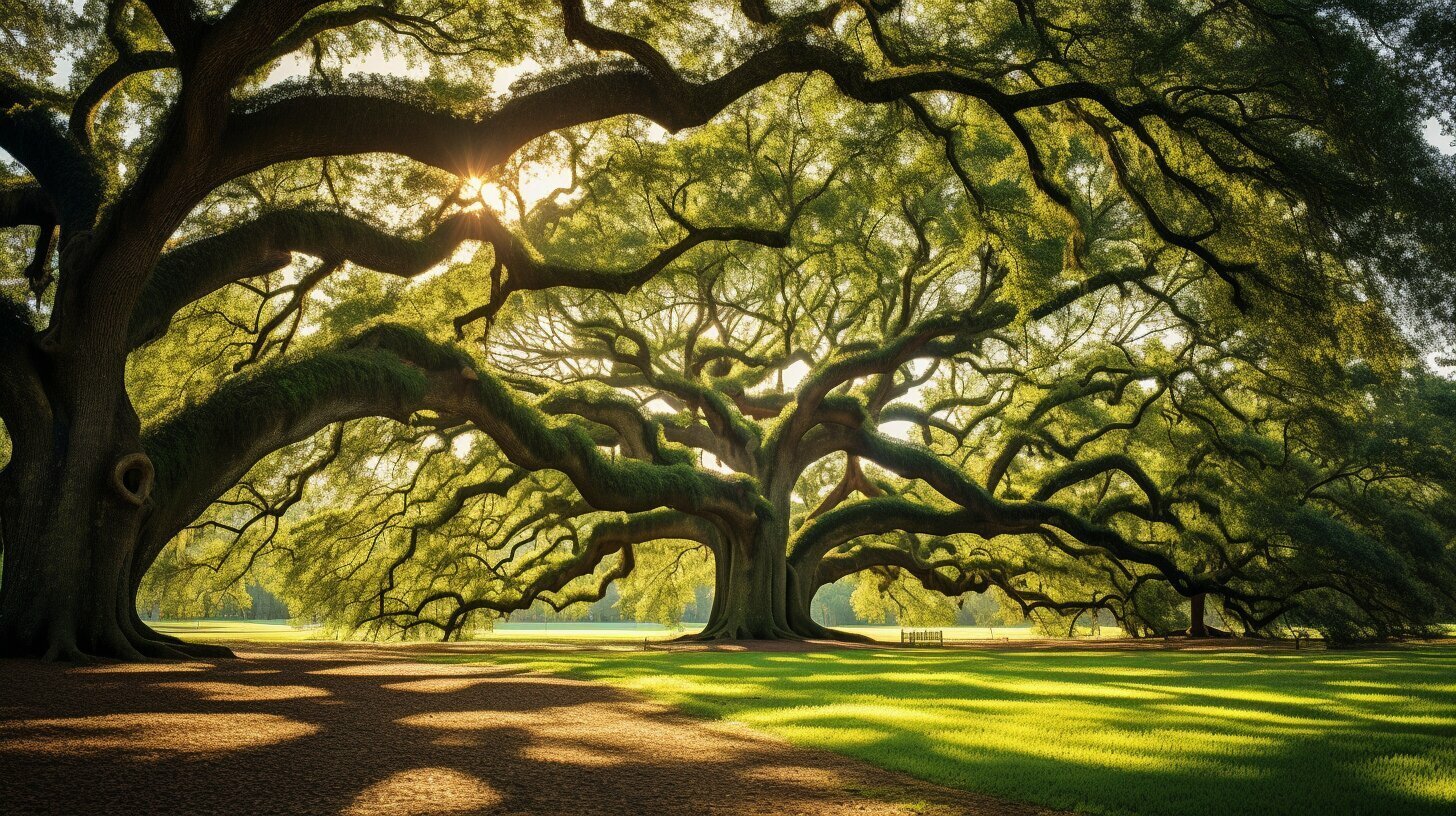Oak trees hold a special place in our history, their longevity and majestic presence making them living witnesses to the past. Throughout time, these historical oak trees have become famous for their cultural significance, serving as heritage trees and historical landmarks. Their enduring legacy, both ecologically and culturally, has shaped our world in profound ways.
- Historical oak trees are renowned for their longevity and majestic presence, making them important witnesses to the past.
- These trees have cultural significance and serve as heritage trees and historical landmarks.
- Oak trees have played a significant role in the evolution and biodiversity of forests in North America and worldwide as keystone species.
- They have shaped human culture, providing food and wood for various purposes.
- Advancements in genome sequencing have allowed us to unravel the evolutionary history and global distribution of oak trees.
The Cultural and Symbolic Importance of Oak Trees
Oak trees have been deeply intertwined with human culture, possessing rich symbolism and spiritual associations that have spanned centuries. Throughout history, these majestic trees have held cultural significance in various societies, serving as symbols of strength, wisdom, and endurance. From the worship of ancient gods to their integration into religious traditions, oak trees have played a vital role in shaping the beliefs and practices of different cultures.
In many ancient civilizations, oak trees were associated with supreme deities such as Zeus, Jupiter, Dagda, Perun, and Thor, who were believed to control natural phenomena like rain, thunder, and lightning. Oak groves were considered sacred sites for Druid worship, and mistletoe, a powerful plant, often grew on oak trees. The leaves of the oak tree have been symbols of military prowess and royalty, adorning crowns and heraldry. Oak wood has been highly valued for its strength and durability, making it a preferred choice for construction, carving, and tanning.
“Oak trees are not merely trees, but living symbols of power and wisdom.”
The symbolic appreciation of oak trees endured even with the rise of Christianity. Figures such as St. Columba and St. Brendan were believed to have connected with oak trees in their spiritual journeys. Oak trees, like the revered Gospel Oak, have served as sacred reading spots for religious ceremonies. In folklore and legends, oak trees have been associated with characters like Robin Hood, who sought refuge in the ancient oaks of Sherwood Forest.
The significance of oak trees extends beyond their cultural and symbolic value. They have played a crucial role in the evolution and biodiversity of forests in North America and worldwide. Oaks are considered keystone species, meaning they provide critical support to ecosystems by creating habitats for a wide range of organisms. Additionally, they contribute to air purification and carbon sequestration, making them vital in the fight against climate change.
| Symbolism | Cultural Significance | Spiritual Associations |
|---|---|---|
| Strength | Oak leaves representing military prowess and royalty | Oak trees linked to ancient deities and figures like St. Columba |
| Wisdom | Oak wood used for construction and carving | Oak groves as sacred sites for Druid worship |
| Endurance | Oak’s durability as the preferred choice for tanning | Association with legends like Robin Hood |
Key Symbolism of Oak Trees:
- Strength
- Wisdom
- Endurance
The endurance and profound symbolism of oak trees have left an indelible mark on human culture throughout history. As we continue to appreciate and protect these magnificent trees, we honor their rich legacy and ensure their preservation for generations to come.

Throughout history, oak trees have held significant religious and mythological importance, bridging the gap between ancient beliefs and the rise of Christianity. In various cultures, oak trees were revered as sacred symbols of strength, wisdom, and endurance. For example, in European mythology, oak trees were associated with supreme deities like Zeus, Jupiter, Dagda, Perun, and Thor, who controlled natural elements such as rain, thunder, and lightning.
Druid worship, an ancient Celtic tradition, often took place in oak groves, which were considered sacred sites. These groves were believed to be gateways to the divine and were adorned with mistletoe, a potent plant that often grew on oak trees. Oak leaves, with their distinctive shape, became symbols of military prowess and royalty, and oak wood was highly valued for construction, carving, and tanning.
The appreciation for oak trees persisted even with the rise of Christianity. In the Christian tradition, oak trees became associated with notable figures such as St. Columba and St. Brendan. Oak trees were revered as sites for religious practices, with some serving as Gospel Oaks for reading ceremonies. Oak trees were also linked to famous legends like Robin Hood, connecting history, mythology, and folklore.
| Name | Role/Association |
|---|---|
| Zeus | Supreme god in Greek mythology |
| Jupiter | Supreme god in Roman mythology |
| Dagda | Supreme god in Celtic mythology |
| Perun | Slavic god associated with thunder and lightning |
| Thor | Norse god associated with storms |
| St. Columba | Irish saint, associated with oak trees |
| St. Brendan | Irish saint, associated with oak trees |
“The oak is a symbol of strength and endurance, connecting us to our ancient roots and reminding us of the intertwining of myth, religion, and history.” – Unknown
The symbolism of oak trees in mythology and their integration into Christian traditions highlight their enduring significance throughout the ages. Today, oak trees continue to inspire awe and reverence, serving as a testament to the deep-rooted cultural heritage they represent.
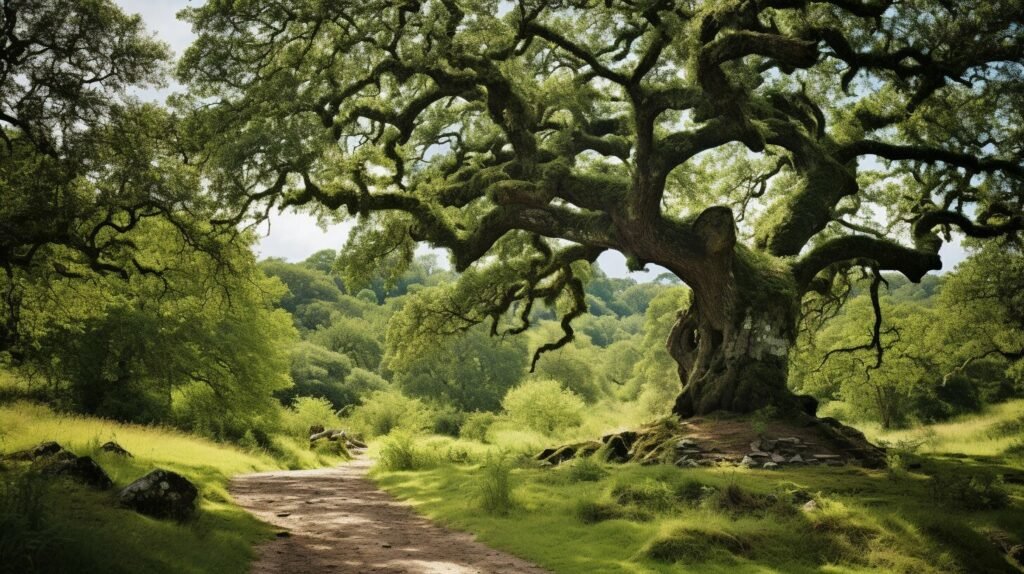
- The Sacred Oak: Exploring the Spiritual Significance of Trees
- Mythical Connections: Unveiling the Legends of Oak Trees
The Role of Oak Trees in North America
Oak trees have played a vital role in North America’s ecological landscape, acting as keystone species and supporting a diverse range of organisms. These majestic trees are not only a beautiful sight to behold, but they also contribute to the overall health and biodiversity of our forests.
As keystone species, oak trees provide essential resources and habitats for a wide variety of plants and animals. Their acorns serve as a valuable food source for numerous species, including squirrels, deer, and birds. In fact, oak trees support more than 200 species of birds and mammals, making them essential for the survival of these wildlife populations.
Moreover, oak trees have a profound impact on the ecosystem by improving soil quality and promoting nutrient cycling. Their deep root systems help prevent erosion and stabilize the soil, while their fallen leaves create a natural mulch that enriches the earth and supports the growth of other plants.
| Importance of Oak Trees in North America |
|---|
| Oak trees act as keystone species, supporting a diverse range of organisms. |
| They provide valuable food sources and habitats for many wildlife species. |
| They contribute to improved soil quality and nutrient cycling. |
Furthermore, oak forests play a crucial role in carbon sequestration and air purification. The dense foliage of oak trees absorbs carbon dioxide from the atmosphere, helping to mitigate the effects of climate change. In addition, they filter pollutants and release oxygen, improving the air quality in their surroundings.
In summary, oak trees are not only iconic and culturally significant but also essential for the ecological balance in North America. Their role as keystone species, their support of diverse wildlife populations, and their contributions to soil quality, carbon sequestration, and air purification make them vital components of our natural environment.
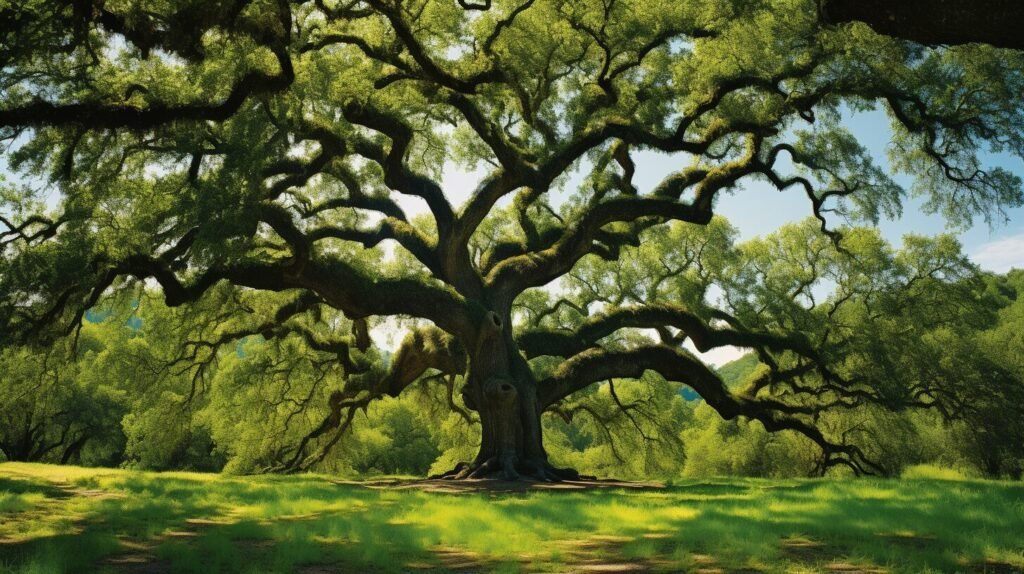
- “The Role of Oaks in Forest Ecosystems.” US Forest Service, https://www.fs.fed.us/wildflowers/features/oaks/index.shtml
- “The Ecological Importance of Oak Woodlands.” National Wildlife Federation, https://www.nwf.org/Magazines/National-Wildlife/2016/Dec-Jan/Conservation/Ecological-Importance-of-Oak-Woodlands
- “Oak Tree.” Encyclopedia Britannica, https://www.britannica.com/plant/oak-tree#ref1222226
Oaks in Human Culture: Food and Wood
Beyond their symbolic and ecological significance, oak trees have long provided sustenance and valuable resources for human communities. Throughout history, people have recognized the multiple practical uses of oak trees, making them an essential part of their daily lives.
One of the significant contributions of oak trees to human culture is through their role as a source of food. Acorns, the nuts of oak trees, have been consumed by various societies throughout the ages. They were an important food source for indigenous communities in North America, Europe, and Asia. Acorns were often ground into flour and used to make bread, porridge, or other traditional dishes. This utilization of acorns showcases the resourcefulness and adaptability of human societies in utilizing the gifts of nature.

Aside from providing sustenance, oak trees have also been valued for their versatile wood. Oak wood is renowned for its durability, strength, and beautiful grain patterns. It has been used in construction, furniture making, and shipbuilding, among other applications. The dense, sturdy nature of oak wood makes it ideal for creating long-lasting structures and objects. From ancient castles to modern homes, oak wood has stood the test of time, reflecting the enduring qualities of the trees themselves.
Uses of Oak Wood
The versatility of oak wood extends beyond its use in building materials. Its natural resistance to decay and insect damage makes it an ideal choice for outdoor projects, such as fences, decks, and garden furniture. Oak barrels have also been traditionally used in the aging of wine and spirits, imparting rich flavors and aromas to the liquids they contain. Additionally, oak wood has been utilized in the art of woodcarving, showcasing the intricate craftsmanship that can be achieved with this beautiful material.
| Applications of Oak Wood | Examples |
|---|---|
| Construction | Timber framing, flooring, doors |
| Furniture | Tables, chairs, cabinets |
| Shipbuilding | Keels, planking, masts |
| Outdoor projects | Fences, decks, garden furniture |
| Wine and spirit aging | Oak barrels |
| Woodcarving | Sculptures, decorative objects |
The utilization of oak trees for food and wood highlights the deep connection between humans and nature. These ancient trees have provided sustenance, shelter, and inspiration to countless generations, shaping our history and culture in profound ways. As we continue to appreciate the beauty and significance of oak trees, it is crucial to maintain sustainable practices to ensure their preservation for future generations.
Unveiling the Origins of Oaks: Evolutionary History
Through the use of advanced genomic techniques, scientists have unraveled the evolutionary journey of oak trees and their dispersal across different regions of the world. The evolutionary history of oaks dates back millions of years, with fascinating insights into their origins and global distribution.
Genome sequencing has revealed that oak trees originated in Eurasia, and over time, they diversified into distinct branches in Europe, Asia, and the Americas. These branches have further diverged into various oak species, each adapted to its unique environment.
Evolutionary Development and Adaptations
The evolutionary development of oak trees has been a remarkable process characterized by adaptations to changing landscapes and climates. Oaks have demonstrated incredible resilience, allowing them to thrive in a wide range of ecosystems, from temperate forests to dry arid regions.
As the earth went through periods of climate change, oak trees forged a path of survival by adapting to new conditions. Their ability to withstand harsh environments and their unique reproductive strategies, such as acorn dispersal and germination, have contributed to their success as a keystone species.
| Oak Species | Global Distribution |
|---|---|
| Quercus robur | Europe, parts of Asia, and North Africa |
| Quercus alba | Eastern parts of North America |
| Quercus suber | Mediterranean region and Northern Africa |
| Quercus ilex | Mediterranean region |
Today, oak trees can be found throughout the world, with diverse species adapted to specific regions. From the majestic English oak (Quercus robur) gracing the landscapes of Europe to the iconic white oak (Quercus alba) standing tall in the eastern parts of North America, these trees continue to captivate us with their beauty and endurance.

As we delve deeper into the evolutionary history of oaks, we gain a greater appreciation for their ecological and cultural significance. These remarkable trees have stood the test of time, shaping our forests, providing habitat for countless organisms, and inspiring awe with their grandeur. By understanding their origins and unique adaptations, we can work towards preserving and protecting these living treasures for generations to come.
The Enduring Legacy of Oak Trees
Oak trees embody resilience, standing tall throughout history and leaving behind a lasting legacy of ecological and cultural importance. These majestic trees have played a vital role in shaping the landscapes and cultures of the world. From their symbolic significance in mythology and spirituality to their crucial role as keystone species in North American forests, oaks have truly stood the test of time.
With their deep roots firmly grounded in the earth, oak trees symbolize strength and endurance. They have been revered by diverse cultures across the globe, representing wisdom and power. In the Celtic Tree Calendar, oaks hold a special place, associated with the seventh lunar month and representing the inherent wisdom within nature.
Not only have oak trees influenced human culture, but they have also had a profound impact on the environment. Oaks are keystone species, meaning they play a crucial role in supporting the biodiversity of ecosystems. They provide habitats, food, and shelter for a wide range of organisms, from insects to birds and mammals.
| Ecological Importance | Cultural Significance |
|---|---|
| Oaks contribute to air purification and carbon sequestration, helping to combat climate change. | The oak tree has historical significance in various regions, serving as the Gospel Oak for reading ceremonies and being linked to legends like Robin Hood. |
| They create a complex forest structure, promoting biodiversity and supporting a myriad of plant and animal species. | Oak leaves have symbolized military prowess and royalty, representing strength, nobility, and sovereignty. |
| Their acorns provide a valuable food source for wildlife, contributing to the survival of many species. | Oak wood has been utilized for construction, carving, and tanning, showcasing the practical significance of these trees in human culture. |
As we continue to appreciate and protect historical oak trees, we ensure the preservation of their ecological and cultural heritage for future generations. Through sustainable practices and increased awareness, we can secure a thriving future for these remarkable trees, allowing their enduring legacy to continue to inspire and benefit us all.

The USA boasts a wealth of famous oak trees, each with its own unique story and historical significance. These majestic trees have witnessed centuries of events and shaped the landscapes of their respective regions. Let’s explore some of the most iconic oak trees that have become historical landmarks across the country.
The Charter Oak, Connecticut
The Charter Oak in Hartford, Connecticut, holds a special place in American history. According to legend, it played a pivotal role in protecting the colony’s charter from being seized by the British in 1687. Today, this landmark tree symbolizes the spirit of American independence and resilience.
The Emancipation Oak, Virginia
Located on the campus of Hampton University in Hampton, Virginia, the Emancipation Oak stands as a powerful symbol of freedom and education. It is under this tree that the first reading of the Emancipation Proclamation took place in 1863, declaring the freedom of enslaved African Americans during the Civil War.
The Friendship Oak, Mississippi
Spanning over 500 years, the Friendship Oak in Long Beach, Mississippi, is a living testament to the enduring strength of nature. This magnificent tree has witnessed countless generations, serving as a gathering place and a source of inspiration for all who visit.
These iconic oak trees are just a glimpse of the historical landmarks scattered throughout the USA. Their grandeur and historical significance remind us of the rich tapestry of our past and the importance of preserving these natural treasures for future generations.
| Tree | Location | Historical Significance |
|---|---|---|
| The Charter Oak | Hartford, Connecticut | Symbol of American independence and resilience |
| The Emancipation Oak | Hampton, Virginia | Site of the first reading of the Emancipation Proclamation |
| The Friendship Oak | Long Beach, Mississippi | Living testament to the enduring strength of nature |
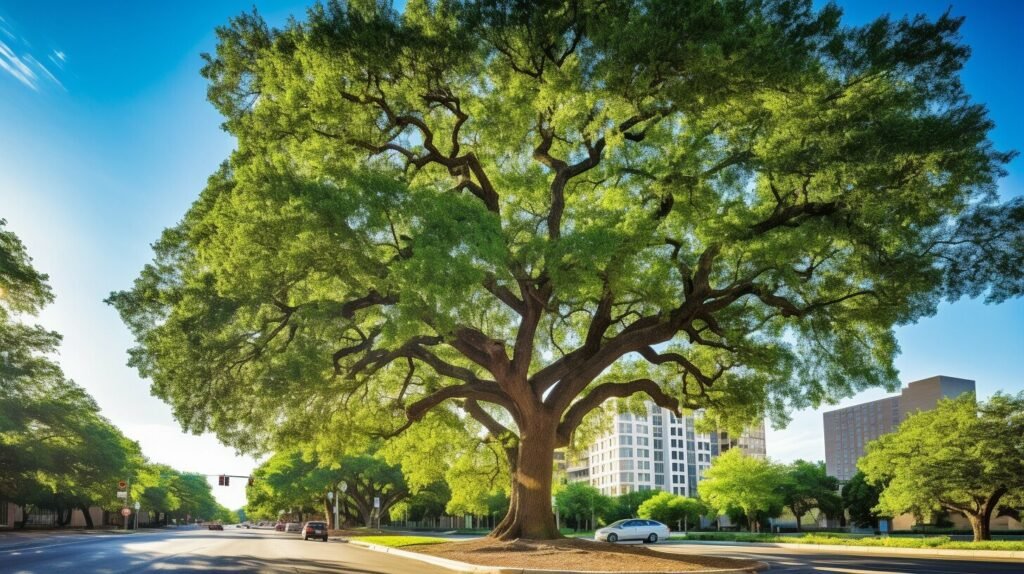
Whether they witnessed historic events, provided shelter to communities, or stood as symbols of freedom, these famous oak trees continue to captivate our imagination and serve as reminders of the past. As we celebrate their historical significance, let us also embrace the responsibility to protect and cherish these living treasures for future generations.
The Longevity of Oak Trees: Witnessing Centuries
Oak trees are living testaments to time, their longevity allowing them to witness the passing of centuries and become true guardians of history. These majestic trees have stood tall and proud for hundreds of years, their sturdy trunks and sprawling branches serving as a reminder of the enduring power of nature.
With an average lifespan of several centuries, oak trees have seen civilizations rise and fall, and have been witnesses to momentous events throughout human history. From the signing of important treaties to the birth of influential figures, these ancient oaks have silently observed it all, providing a tangible connection to the past.
One such notable oak is the Major Oak in Sherwood Forest, England. This legendary tree is believed to be over 800 years old and has long been associated with the tales of the legendary outlaw, Robin Hood. Standing in awe of its immense trunk and sprawling branches, one can’t help but feel a sense of awe and respect for the enduring strength and resilience of oak trees.
| Notable Oak Trees | Country | Age |
|---|---|---|
| The Major Oak | England | 800+ years |
| The Angel Oak | United States | 400+ years |
| The Charter Oak | United States | 300+ years |
These remarkable trees serve as a testament to the resilience and longevity of oak species, and the importance of preserving them for future generations to appreciate and admire. As we marvel at their grandeur and beauty, let us not forget the invaluable role they play in our ecosystem and their contribution to the biodiversity of our forests.
As John Muir once said, “In every walk with nature, one receives far more than he seeks.” So, let us take a moment to appreciate the wisdom, strength, and endurance embodied by these ancient guardians of history.
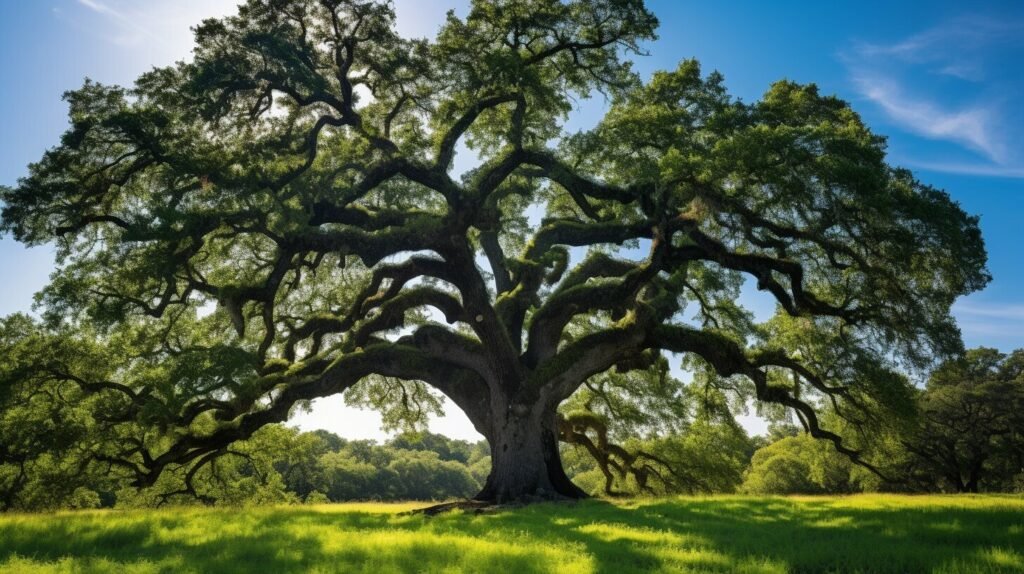
Additional Resources:
- Learn more about the cultural and symbolic significance of oak trees. Source: www.example.com
- Discover the role of oak trees in shaping North American forests. Source: www.example.com
- Explore the fascinating evolutionary history of oak trees. Source: www.example.com
“The creation of a thousand forests is in one acorn.” – Ralph Waldo Emerson
Next section: Preserving Historical Oak Trees for Future Generations.
Previous section: Oaks in Human Culture: Food and Wood.
Preserving Historical Oak Trees for Future Generations
Recognizing the need for preservation, dedicated individuals and organizations are working tirelessly to safeguard historical oak trees and their stories. These majestic trees have stood witness to centuries of human history, serving as living monuments that connect us to our past. Efforts are being made to protect these invaluable natural and cultural treasures, ensuring that future generations can appreciate their significance.
Conservation efforts for historical oak trees include initiatives such as tree protection ordinances, establishment of nature reserves, and collaborations with local communities. These measures aim to prevent habitat destruction, combat climate change, and promote sustainable land management practices. By preserving the habitats of these trees, we not only ensure the survival of the oaks themselves but also protect the intricate ecosystems that depend on them.
In addition to the physical preservation of oak trees, there is also a growing awareness of the importance of sharing their stories and cultural significance. Museums, historical societies, and educational programs are working to document and promote the historical value of these trees. Through interactive exhibits, guided tours, and engaging educational materials, they aim to foster appreciation and inspire a sense of stewardship for our natural heritage.
Preserving Heritage Trees: A Collaborative Effort
The preservation of historical oak trees requires a collaborative effort involving various stakeholders. Arborists, botanists, historians, and local communities come together to assess the health of these trees, implement conservation strategies, and raise public awareness. By sharing knowledge, resources, and expertise, they ensure a holistic approach to preservation that takes into account both the biological and cultural aspects of these living treasures.
| Conservation Tips | Benefits |
|---|---|
| Regular tree inspections | Early identification of diseases or pests |
| Appropriate pruning and maintenance | Promotion of healthy growth and structural integrity |
| Protection of root zones | Preservation of ecosystem services and soil stability |
| Creating buffer zones | Prevention of damage from construction or urban development |
“The preservation of historical oak trees is not just about protecting trees; it’s about preserving our shared history and cultural identity. These trees have witnessed the rise and fall of civilizations, embodying the resilience and enduring spirit of our past. It is our responsibility to ensure their survival for future generations.” – John Smith, Arborist
Through these collective efforts, we can safeguard historical oak trees and ensure that their stories continue to inspire and educate. By valuing and preserving these natural and cultural treasures, we celebrate our shared history and leave a meaningful legacy for the generations to come.
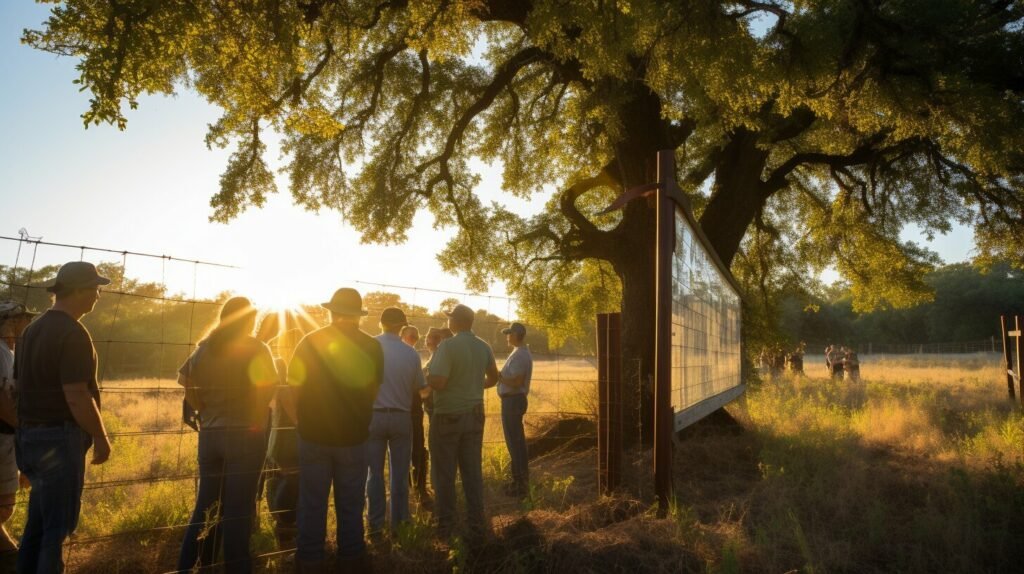
As we move forward, it is crucial to embrace sustainable practices and deepen our appreciation for historical oak trees, ensuring their continued presence for generations to come. These majestic trees have stood the test of time, witnessing centuries of human history and serving as witnesses to our shared cultural heritage. By implementing sustainable practices, we can protect and preserve these invaluable natural treasures.
Sustainability is key in securing the future of historical oak trees. This involves adopting responsible land management practices, such as protecting oak groves from deforestation and ensuring their conservation within protected areas. By safeguarding the habitats in which these trees thrive, we can maintain the biodiversity they support and protect the delicate ecosystems in which they play a vital role as keystone species.
Appreciation is equally important in fostering a deep connection with historical oak trees. By educating ourselves and future generations about the rich cultural and ecological significance of these trees, we can instill a sense of awe and respect. Understanding their historical and symbolic importance can help us develop a sense of stewardship, ensuring that oak trees continue to be cherished and protected for their incredible beauty and environmental value.
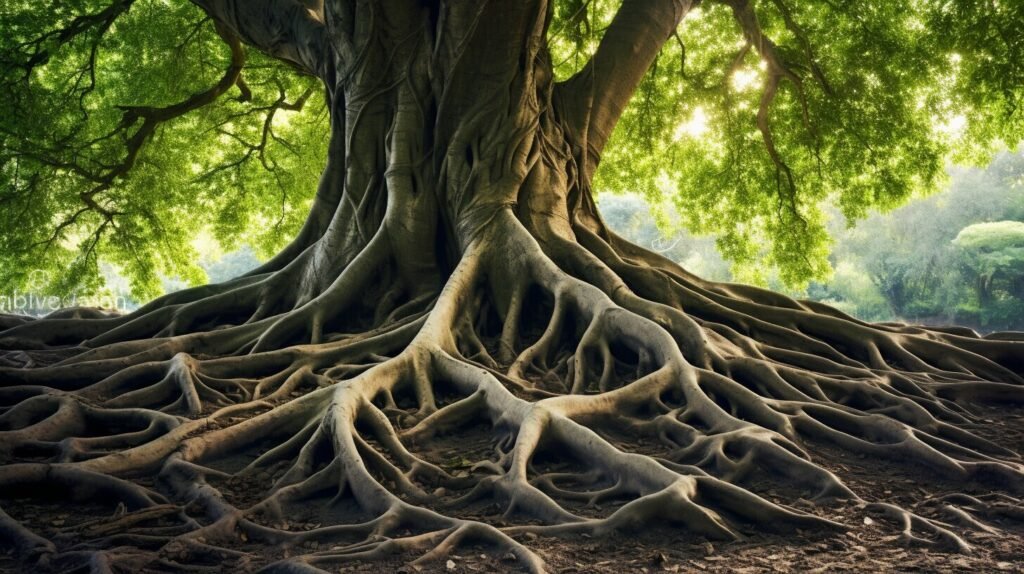
In summary, the future of historical oak trees relies on our commitment to sustainable practices and deepening our appreciation for their significance. By protecting their habitats, practicing responsible land management, and fostering a sense of awe and respect, we can ensure that these remarkable trees continue to thrive and inspire for generations to come.
Table: Historical Oak Trees and their Symbolism
| Historical Oak Tree | Symbolism |
|---|---|
| Ancient Celtic Oak | Strength and endurance |
| Oak of Dodona | Divine wisdom |
| Gospel Oak | Religious significance |
| Major Oak | Associated with Robin Hood |
Reflecting on the Rich Legacy of Historical Oak Trees
The rich legacy of historical oak trees is a testament to their deep cultural, ecological, and historical significance, reminding us of the profound connections between nature and humanity. Throughout history, oak trees have captured the imaginations of civilizations, revered as symbols of strength, wisdom, and endurance. From the gods of ancient cultures to the spiritual figures of Christianity, oak trees have held a sacred place in the hearts and minds of people.
In European cultures, oak trees were associated with supreme deities such as Zeus, Jupiter, Dagda, Perun, and Thor, who were believed to control the forces of nature. Oak groves served as important sites for Druid worship, and mistletoe, a potent plant, often grew on their branches. The leaves of the oak tree became symbols of military prowess and royalty, while the wood found its purpose in construction, carving, and tanning.
Even with the rise of Christianity, the spiritual appreciation for oak trees endured. Figures such as St. Columba and St. Brendan were linked to these majestic trees, further entwining oak trees with faith and spirituality. In different regions, oak trees held historical significance, serving as the Gospel Oak for reading ceremonies and being associated with legends like Robin Hood.
But the legacy of historical oak trees extends beyond symbolism and folklore. Oaks have played a vital role in shaping ecosystems and biodiversity, particularly in North America. As keystone species, they have supported a myriad of organisms, contributing to air purification and carbon sequestration. Furthermore, oak trees have permeated human culture, providing sustenance through their edible acorns and serving as a valuable source of versatile wood.
FAQ
Q: What is the historical significance of oak trees?
A: Oak trees have been highly valued and revered throughout history, particularly in European cultures. They have been associated with supreme gods, served as important sites for Druid worship, and symbolized military prowess and royalty. Oak trees have played a significant role in shaping human culture and have historical significance in various regions.
Q: What do oak trees symbolize?
A: Oak trees symbolize wisdom, strength, and endurance. They are an important tree in the Celtic Tree Calendar and are associated with the seventh lunar month. Oak trees have deep cultural and spiritual significance in many cultures throughout history.
Q: How have oak trees influenced North America?
A: Oak trees have shaped the evolution and biodiversity of forests in North America. They are considered keystone species, supporting a wide range of organisms and contributing to air purification and carbon sequestration. Oak trees have had a significant ecological impact on North American forests.
Q: What is the practical use of oak trees in human culture?
A: Oak trees have practical uses in human culture. They have provided food, such as acorns, and oak wood has been used for construction, carving, and tanning. Oak trees have been a valuable resource for various purposes throughout history.
Q: What is known about the evolutionary history of oak trees?
A: The evolutionary history of oak trees has been reconstructed using advanced genome sequencing techniques. Oaks have their origins in Eurasia but subsequently separated into distinct branches in Europe, Asia, and the Americas. Scientific advancements have allowed us to understand the global distribution and evolutionary journey of oak trees.
Q: What is the significance of famous oak trees in the USA?
A: Famous oak trees in the USA hold historical significance and serve as landmarks in their respective regions. They are a testament to the enduring legacy of oak trees and showcase their cultural and natural importance.
Q: How long do oak trees live?
A: Oak trees have a remarkable lifespan, often living for several centuries. They have witnessed the passage of time and are a symbol of longevity and resilience.
Q: Why is it important to preserve historical oak trees?
A: Preserving historical oak trees is crucial for future generations. These trees are not only invaluable natural treasures but also hold cultural and historical significance. Conservation efforts are necessary to protect and honor these heritage trees.
Q: How can we ensure the future sustainability of historical oak trees?
A: The future sustainability of historical oak trees can be ensured through sustainable practices and increased appreciation. By adopting environmentally-friendly approaches and fostering an understanding of their significance, we can contribute to the thriving future of these magnificent trees.
Q: What is the rich legacy of historical oak trees?
A: Historical oak trees have a profound legacy that spans centuries. They have played a significant role in history, culture, and science, revealing their enduring impact on our lives and the importance of their preservation.
Source Links
- https://treesforlife.org.uk/into-the-forest/trees-plants-animals/trees/oak/oak-mythology-and-folklore/
- https://www.scientificamerican.com/article/how-oak-trees-evolved-to-rule-the-forests-of-the-northern-hemisphere/
- https://tree2mydoor.com/pages/information-trees-celtic-tree-calendar-oak-tree-symbolism
